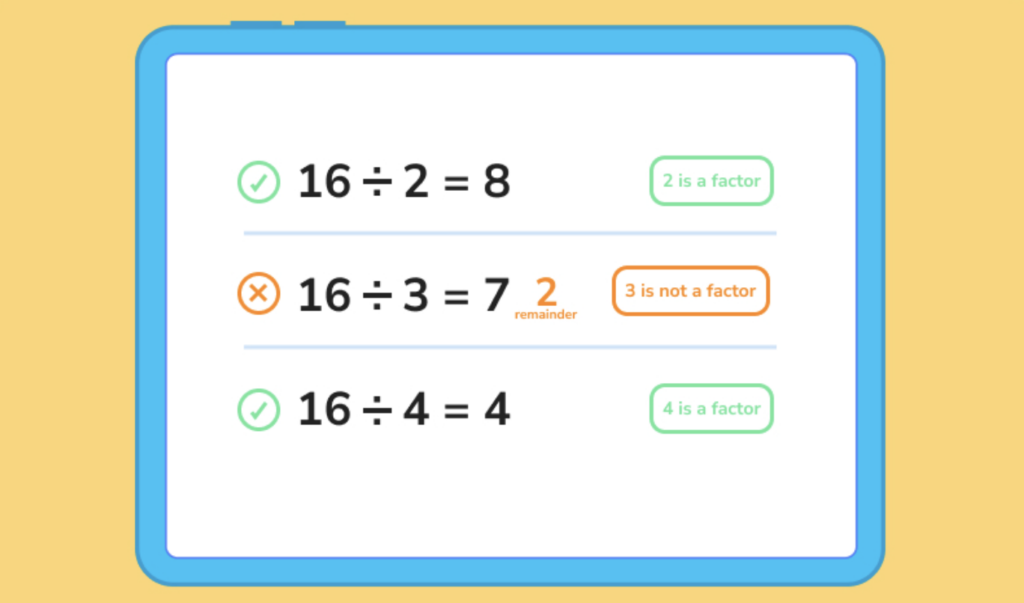In this guide, learn how factors ‘factor’ into all areas of maths!

Author
Taylor Hartley

Expert Reviewer
Jill Padfield
Published: November 3, 2023


In this guide, learn how factors ‘factor’ into all areas of maths!

Author
Taylor Hartley

Expert reviewer
Jill Padfield
Published: November 3, 2023




In this guide, learn how factors ‘factor’ into all areas of maths!

Author
Taylor Hartley

Expert reviewer
Jill Padfield
Published: November 3, 2023


Key takeaways
Table of contents
Factors are a nice first step in seeing the many ways different maths rules and concepts overlap. When you find the factors of numbers, you’ll begin to notice patterns. These patterns, and the process of finding fractions itself, reveal just how interconnected everything you are learning about maths is!
In short, factors are whole numbers that you can divide another number by and get a whole quotient.
Remember, a whole quotient is an answer that is a complete number with no remainder. Every number has its own set of factors, and you find factors the same way for all numbers.
When beginning to think about factors, it helps to look at numbers as groups of other numbers. For example, you can split 12 into one group of 12, two groups of 6, or three groups of 4.
Sometimes, thinking about objects can make this process easier to visualise. Let’s imagine 12 ducks hanging out on a pond. Those ducks can float around in groups of 1, 2, 3, 4, 6, and 12, and not a single quacker would be left out!
That’s basically what factoring is: thinking about the different ways you can divide a starting number without getting a remainder.
Based on the example above, the numbers 1, 2, 3, 4, 6, and 12 are all factors of 12. This is because when you divide 12 by any of these numbers, the answer is whole. 12 ÷ 2 = 6, 12 ÷ 3 = 4, and so on.
For all numbers, 1 and the number itself are technically factors.
For example, with the number 54, both 1 and 54 are factors. Because this rule is true for every number, you may see problems where 1 and the number itself are not included when listing out factors.
We’ll include them as a reminder that they are factors, but remember, you may not see them listed as factors elsewhere.
If you’re looking for a way to remember what a factor is, think about the word ‘factory’. They sound pretty similar, right? Well, that’s because they both come from the Latin word for ‘make’! Factories make things, and factors make up other numbers. If you make that connection in your head, you’ll have a much easier time remembering the ins and outs of factors.
There’s one more thing to cover before we dive into exactly how you find the factors of a number. When finding these factors, you’re going to be finding prime and composite numbers.
What does this mean? Well, prime numbers are numbers that are only divisible by 1 and themselves. For instance, the number 3 is only divisible by 1 and 3, so it is a prime number.
The number 1, however, is the sole exception to this rule. This is because 1 is technically not a prime number. 1 is divisible by 1, but that is all. For a number to be prime, it needs to be divisible by 1 and at least one other number. That means 1 does not count.
Composite numbers are numbers with more than two factors. Basically, if a number is not prime, it is probably composite.
The main exceptions to these rules are the numbers 1 and 0.
Unlock unlimited maths questions
Put your skills to the test with fun exercises + maths games that are proven to boost ability!
Want to learn more about factors? DoodleMaths is an app that’s filled with games and questions exploring multiplication, shapes and more!
Designed to be used ‘little and often’, it creates each child a unique work programme tailored to their needs, boosting their confidence and ability in maths.
Best of all, it sets work at just the right level of challenge, letting every child work independently. Try it for free today!

Now that you know the basics, let’s get to factoring!
The most straightforward way to find factors is to start with the dividend, or the number that will be divided. Then, go through each counting number and see which ones the dividend is evenly divisible by. Continue this process all the way up to the number itself. Let’s see this in action.
Okay, what are the factors of 16? Well, we know that all numbers are divisible by 1 and themselves, so 1 and 16 are factors of 16. Now we just need to check all of those between 1 and 16.

Simply follow this process until you get to 12!
This leaves you with the factors 1, 2, 4, 6, 8, and 16. Remember the section about prime and composite numbers? 2 is prime because it is divisible by just 1 and 2 (itself). The rest of the factors are composite.
Factoring this way takes a little bit of time. To speed things up, let’s learn about those patterns mentioned at the beginning of the lesson. There’s sort of a secret code in maths that allows you to anticipate patterns, and this is true to factoring.
For example, if the number is even, you know it has to be divisible by 2, which means 2 is a factor.
The answer you get when you divide by 2 is also a factor. Just look at the factors of 16 above. Since 2 x 8 = 16, both 2 and 8 are factors.
Aside from the number itself, there will never be a factor greater than the number divided by 2. For instance, 16 is largest possible factor (besides itself), is 8. Therefore, you can stop checking for factors once you get to 8, saving yourself a whole lot of time.
Additionally, if the dividend is not even, you know none of the factors will be even either. So, you can skip trying to divide any even number into an odd number, cancelling out half of your possible factors!
Here’s another trick: if the digits in the dividend add up to a number divisible by 3, the entire number is divisible by 3!
For example, the number 132. 1 + 3 + 2 = 6. 6 is divisible by 3, so 132 is also divisible by 3. Additionally, just like with 2, if you divide by 3, the answer you get is a factor. This is true for any factor you find!
Here’s one more trick: any number that ends in 0 or 5 will be divisible by 5, and any number that ends in 0 is divisible by 10.
With these tricks and patterns in mind, you can quickly find the factors of any number.
When factoring large numbers, it’ll take a super long time to test every individual number. Instead, factor out the factors you have already found until you’re left with nothing but prime numbers.
For example, if you wanted to factorise 81, you could easily get 1, 3, 27, and 81 using the tricks we previously covered. After that, you factor the factors! 27 can be factorised into 3 and 9, and since 9 is a factor of 27, it is also a factor of 81.
Factoring all the factors until you are left with nothing but prime numbers is called prime factorisation. Prime factorisation is key to helping you find the factors of larger numbers.
Find the factors of 23
Find the factors of 72
Find the factors of 38
Which number is prime, 67 or 90?
Find the factors of 100
In maths, a factor is a number you can use to divide another number without any remainder.
Go through all the counting numbers and use them to divide the number you’re trying to factorise.
Each counting number that divides the starting number (or the dividend) into a whole number is a factor.
Look for even numbers, numbers where the digits add up to a number divisible by 3, and numbers that end in 0 and 5. These can all be quickly divided to find many factors.
Prime numbers are numbers that can be factored only into 1 and the number itself. 1 doesn’t count as a prime number.

Parents, sign up for a DoodleMaths subscription and see your child become a maths wizard!

1 and 23
How did we get here?
1, 2, 3, 4, 6, 8, 9, 12, 18, 24, 36, and 72
How did we get here?
1, 2, 19, and 38
How did we get here?
67 is prime
How did we get here?
1, 2, 4, 5, 10, 20, 25, 50, and 100
How did we get here?
Lesson credits

Taylor Hartley
Taylor Hartley is an author and an English teacher based in Charlotte, North Carolina. When she's not writing, you can find her on the rowing machine or lost in a good novel.

Jill Padfield
Jill Padfield has 7 years of experience teaching mathematics. She is currently working as a Business Analyst, working to improve services for Veterans while earning a masters degree in business administration.

Taylor Hartley
Taylor Hartley is an author and an English teacher based in Charlotte, North Carolina. When she's not writing, you can find her on the rowing machine or lost in a good novel.

Jill Padfield
Jill Padfield has 7 years of experience teaching mathematics. She is currently working as a Business Analyst, working to improve services for Veterans while earning a masters degree in business administration.
Book a chat with our team
If you’d like to use Doodle’s browser version, please visit this page on a desktop.
To log in to Doodle on this device, you can do so through our apps. You can find out how to download them here: